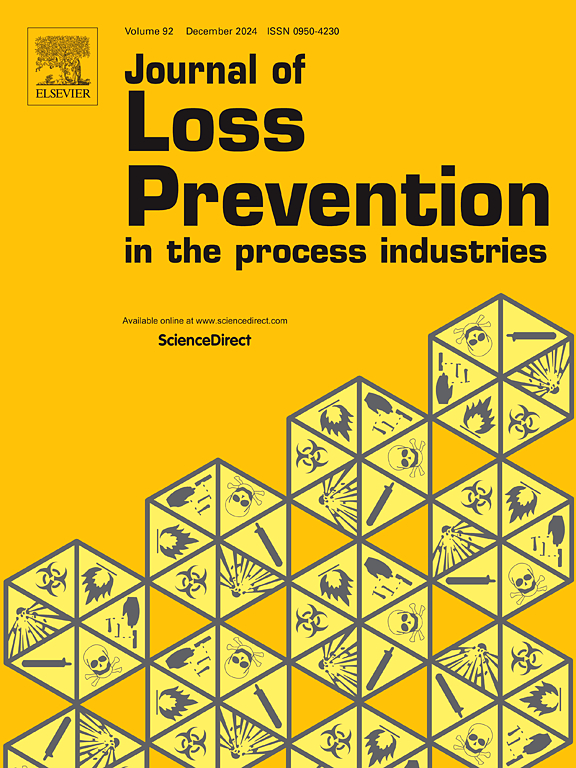Synthesis, comprehensive characterization and comparative flame retardancy analysis of three metal-organic frameworks incorporated into epoxy resin
IF 3.6
3区 工程技术
Q2 ENGINEERING, CHEMICAL
Journal of Loss Prevention in The Process Industries
Pub Date : 2025-03-25
DOI:10.1016/j.jlp.2025.105645
引用次数: 0
Abstract
Epoxy resin (EP), a prevalent thermoset material, is renowned for its exceptional corrosion resistance, thermal stability, and mechanical properties. However, its high flammability and toxic smoke emission pose significant concerns, necessitating the enhancement of its flame retardancy. Metal-organic frameworks (MOFs), with their reticulated structures and porous characteristics, exhibit superior thermal insulation and adsorption properties. Through comparative experiments, we aim to optimize MOF flame retardant formulations to bolster the flame resistance of EP and then enhance its fire safety. In this work, Cu-MOF, Fe-MOF, and Co-MOF were successfully synthesized at room temperature for meeting the requirements of intrinsic safety and then incorporated into EP at a 5 wt% loading to create advanced EP/MOFs composites. The investigation revealed that all three MOFs effectively elevated the limiting oxygen index and reduced smoke density rating of EP. Notably, EP/Co-MOF stood out in suppressing smoke and heat release, with reductions of 40.5 % in peak specific heat release rate (PSPR), 26.4 % in total smoke production (TSP), and 44.4 % in peak heat release rate (pHRR) compared to EP. Furthermore, EP/Co-MOF demonstrated superior compatibility compared to EP/Cu-MOF and EP/Fe-MOF, mitigating mechanical degradation. Consequently, Co-MOF emerges as a promising flame retardant and smoke suppressant for EP, showcasing significant application potential.

环氧树脂中三种金属有机骨架的合成、综合表征及阻燃性能对比分析
环氧树脂(EP)是一种流行的热固性材料,以其优异的耐腐蚀性,热稳定性和机械性能而闻名。然而,它的高可燃性和有毒烟雾排放引起了人们的极大关注,需要对其阻燃性进行增强。金属有机骨架(MOFs)具有网状结构和多孔特性,具有优异的保温和吸附性能。通过对比实验,优化MOF阻燃剂配方,提高EP的阻燃性能,进而提高其防火安全性。在本工作中,Cu-MOF, Fe-MOF和Co-MOF在室温下成功合成,以满足本质安全要求,然后以5 wt%的负载加入EP中,以制备先进的EP/ mof复合材料。结果表明,三种MOFs均能有效提高EP的极限氧指数,降低EP的烟密度等级。值得注意的是,EP/Co-MOF在抑制烟雾和热量释放方面表现突出,与EP相比,峰值比热释放率(PSPR)降低了40.5%,总烟雾产量(TSP)降低了26.4%,峰值热量释放率(pHRR)降低了44.4%。此外,与EP/Cu-MOF和EP/Fe-MOF相比,EP/Co-MOF表现出更好的相容性,减轻了机械降解。因此,Co-MOF作为极具前景的EP阻燃和抑烟剂,显示出巨大的应用潜力。
本文章由计算机程序翻译,如有差异,请以英文原文为准。
求助全文
约1分钟内获得全文
求助全文
来源期刊
CiteScore
7.20
自引率
14.30%
发文量
226
审稿时长
52 days
期刊介绍:
The broad scope of the journal is process safety. Process safety is defined as the prevention and mitigation of process-related injuries and damage arising from process incidents involving fire, explosion and toxic release. Such undesired events occur in the process industries during the use, storage, manufacture, handling, and transportation of highly hazardous chemicals.

 求助内容:
求助内容: 应助结果提醒方式:
应助结果提醒方式:


